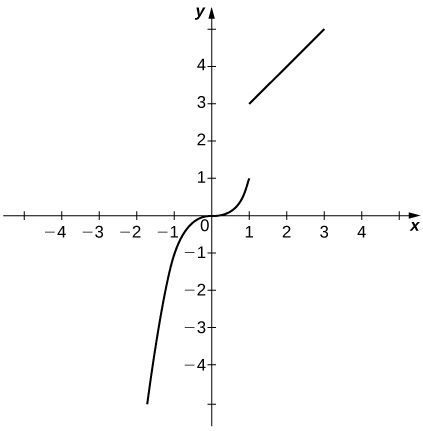| << Chapter < Page | Chapter >> Page > |
In the following exercises, suppose is defined for all x . For each description, sketch a graph with the indicated property.
Discontinuous at with and
Answers may vary; see the following example:

Discontinuous at but continuous elsewhere with
Determine whether each of the given statements is true. Justify your response with an explanation or counterexample.
If the left- and right-hand limits of as exist and are equal, then f cannot be discontinuous at
If a function is not continuous at a point, then it is not defined at that point.
False. Consider
According to the IVT, has a solution over the interval
If is continuous such that and have opposite signs, then has exactly one solution in
False. Consider on
The function is continuous over the interval
If is continuous everywhere and then there is no root of in the interval
False. The IVT does not work in reverse! Consider over the interval
[T] The following problems consider the scalar form of Coulomb’s law, which describes the electrostatic force between two point charges, such as electrons. It is given by the equation where is Coulomb’s constant, are the magnitudes of the charges of the two particles, and r is the distance between the two particles.
To simplify the calculation of a model with many interacting particles, after some threshold value we approximate F as zero.
Instead of making the force 0 at R , instead we let the force be 10 −20 for Assume two protons, which have a magnitude of charge and the Coulomb constant Is there a value R that can make this system continuous? If so, find it.
Recall the discussion on spacecraft from the chapter opener. The following problems consider a rocket launch from Earth’s surface. The force of gravity on the rocket is given by where m is the mass of the rocket, d is the distance of the rocket from the center of Earth, and k is a constant.
[T] Determine the value and units of k given that the mass of the rocket on Earth is 3 million kg. ( Hint : The distance from the center of Earth to its surface is 6378 km.)
[T] After a certain distance D has passed, the gravitational effect of Earth becomes quite negligible, so we can approximate the force function by Find the necessary condition D such that the force function remains continuous.
As the rocket travels away from Earth’s surface, there is a distance D where the rocket sheds some of its mass, since it no longer needs the excess fuel storage. We can write this function as Is there a D value such that this function is continuous, assuming
Prove the following functions are continuous everywhere
For all values of is defined, exists, and Therefore, is continuous everywhere.

Notification Switch
Would you like to follow the 'Calculus volume 1' conversation and receive update notifications?